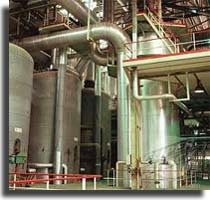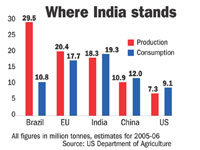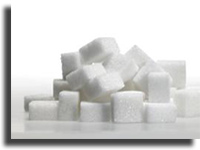| Size of the Industry | Today India has 453 sugar mills those constituting 252 mills from the Co-operative sector and 134 Mills from the private sector. |
| Geographical distribution | Uttar Pradesh, Maharashtra, Karnataka, Gujarat, Tamil Nadu, and Andhra Pradesh |
| Output per annum | India is the largest consumer of sugar and consumes around 16 million tonnes of sugar per annum. |
| Market Capitalization | Total turnover of Rs. 500 billion per annum |
Indian mythology supports the fact it contains legends showing the origin of sugarcane. Today India is the second largest producer of sugarcane next to Brazil. Currently there are about 4 million hectares of land under sugarcane with an average yield of 70 tonnes per hectare.

The traditional sweeteners of India like Gur & Khandsari are consumed mostly by the rural population in the country. In the early 1930's nearly 2/3rd of sugarcane production was used for the production of alternate sweeteners like Gur & Khandsari. As accordingly because of the better standard of living and higher incomes, the sweetener demand has shifted to white sugar. Currently 1/3rd of sugarcane production is used by the Gur & Khandsari sectors.
In the year 1930 there was an advent of modern sugar processing industry in India which was started with grant of tariff protection to the sugar industry. In the year 1930-31 the number of sugar mills increased from 30 to 135 and in the year 1935-36 production was increased from 1.20 lakh tonnes to 9.34 lakh tonnes under the dynamic leadership of the private sector. In the year 1950-51 the era of planning for industrial development began and Government laid down targets of sugar production and consumption, licensed and installed capacity, sugarcane production during each of the Five Year Plan periods.

Indian Sugar Industry generates power for its own requirement and even gets surplus power for export to the grid based on byproduct bagasse. There is even production of ethanol, an ecology friendly and renewable energy for blending with petrol. Sugar Companies have been established in large sugarcane growing states like Uttar Pradesh, Maharashtra, Karnataka, Gujarat, Tamil Nadu, and Andhra Pradesh and are the six states contributing more than 85% of total sugar production in the India. And 57% of total production is together contributed by Uttar Pradesh and Maharashtra. Indian sugar industry has been growing horizontally with large number of small sized sugar plants set up throughout India as opposed to the consolidation of capacity in the rest of the important sugar producing countries and sellers of sugar, where there is greater concentration on larger capacity of sugar plants.

- Extracting juice by pressing sugarcane
- Boiling the juice to obtain crystals
- Creating raw sugar by spinning crystals in extractors
- Taking raw sugar to a refinery for the process of filtering and washing to discard remaining non-sugar elements and hue
- Crystallizing and drying sugar
- Packaging the ready sugar
Growth of India's sugar industry
Year
|
No. of factories in operation |
Installed Capacity (Lakh tonne) |
Actual Sugar Production (In Lakh tonne) |
1950-51 |
139 |
16.7 |
11.0 |
1955-56 |
143 |
17.8 |
18.9 |
1960-61 |
174 |
24.5 |
30.2 |
1965-66 |
200 |
32.3 |
35.4 |
1973-74 |
229 |
43.1 |
39.5 |
1978-79 |
229 |
59.1 |
58.4 |
1985-86 |
339 |
72.7 |
70.2 |
1990-91 |
337 |
98.5 |
120.5 |
1995-96 |
415 |
127.6 |
164.3 |
1999-2000 |
423 |
161.8 |
182.0 |
2000-01 |
437 |
168.2 |
186.0 |
2001-02 |
433 |
176.8 |
185.3 |
2002-03 |
453 |
180.0 |
201.0 |
2003-04(Estimated) |
461 |
185.0 |
170.0 |
Source: Indian Sugar Mills Association |
|||
- Balrampur Chini Mills Ltd.
- Bajaj Hindustan Ltd.
- Andhra Sugars Ltd.
- Thiru Arooran Sugars Ltd.
- Dhampur Sugar Ltd.
People interested for Jobs in Sugar Industry should be a diploma holder in Mechanical or electrical engineering along with the diploma in the sugar technology. At the entry level one can expect a remuneration of Rs 6000-7000 per month and as with experience increases the pay may go up to Rs 6-15 lakh per annum. Sugar technologists are usually employed in sugar factories, alcoholic or non- alcoholic production plants or sugar research labs. The major recruiters in the sugar Industry are IFFCO and National Federation of Co-Operative Sugar Factories.
The following policy initiatives are taken to boost the Sugar industry:
- Government declared the new policy on August 20,1998 with regards to licenses for new factories, which shows that there will be no other sugar factory in a radius of 15 km.
- Setting up of Indian Institute of Sugar Technology at Kanpur is meant for improving efficiency in the industry.
- In the year 1982, the sugar development fund was set up with a view to avail loans for modernization of the industry.
 Recent Press Release
Recent Press Release
 INDIAN Sugar Industry AT A Glance IN 2021 - 2022
INDIAN Sugar Industry AT A Glance IN 2021 - 2022
 INDIAN Sugar Industry AT A Glance IN 2020 - 2021
INDIAN Sugar Industry AT A Glance IN 2020 - 2021
 INDIAN Sugar Industry AT A Glance IN 2019 - 2020
INDIAN Sugar Industry AT A Glance IN 2019 - 2020
 INDIAN Sugar Industry AT A Glance IN 2018 - 2019
INDIAN Sugar Industry AT A Glance IN 2018 - 2019
 INDIAN Sugar Industry AT A Glance IN 2017 - 2018
INDIAN Sugar Industry AT A Glance IN 2017 - 2018
 INDIAN Sugar Industry AT A Glance IN 2016 - 2017
INDIAN Sugar Industry AT A Glance IN 2016 - 2017
 INDIAN Sugar Industry AT A Glance IN 2015- 2016
INDIAN Sugar Industry AT A Glance IN 2015- 2016
 INDIAN Sugar Industry AT A Glance IN 2014 - 2015
INDIAN Sugar Industry AT A Glance IN 2014 - 2015
 INDIAN Sugar Industry AT A Glance IN 2013 - 2014
INDIAN Sugar Industry AT A Glance IN 2013 - 2014
 INDIAN Sugar Industry AT A Glance IN 2012 - 2013
INDIAN Sugar Industry AT A Glance IN 2012 - 2013
 INDIAN Sugar Industry AT A Glance IN 2011 - 2012
INDIAN Sugar Industry AT A Glance IN 2011 - 2012
 Indian Sugar Mill Association
Indian Sugar Mill Association
Indian Industries



 INDIAN SUGAR INDUSTRY
INDIAN SUGAR INDUSTRY